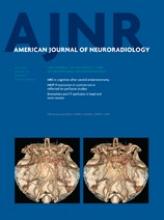We are grateful for the interest of Dr Shibata in our work and appreciate his comments. Although we are partially in agreement with them, we cannot ascertain why he has not noticed, by reading our work, that we obtained similar conclusions. We retrospectively analyzed data from 108 patients with severe head injury defined by a Glasgow Coma Scale (GCS) score of ≤8 at admission or deterioration in the first 48 hours after injury who underwent an MR imaging examination in the first 30 days after trauma.1 From this group of patients with severe trauma, we selected those presenting with identifiable brain stem lesions on MR imaging (51 patients). Imaging was performed in the subacute stage of trauma on a 1.5T scanner. The MR imaging protocol consisted of T1, T2, FLAIR, and gradient-echo T2 images in the 3 orthogonal planes. Data were obtained by using 4-mm-thick sections with a 1-mm skip.
Our series is somewhat different from that presented by Shibata et al,2 because they just included 17 patients with brain stem injury having all degrees of head injury (GCS scores of 14–3; five patients having mild or moderate head injury). In their series, MR imaging was performed within the first 6 days after trauma by using a 0.5T scanner. Images of continuous 10-mm sections in transaxial planes were obtained by using only T1- and T2-weighted images.
Although the series are different, conclusions are in some aspects similar. As Dr Shibata pointed out, this study and previous publications of our work group3,4 state that the best predictor of good outcome is the presence of no injuries detectable at MR imaging. However, as stated by the work of Shibata et al,2 the mere presence of a brain stem injury does not determine a poor outcome. If there is an identifiable injury in the brain stem, the combination of nonhemorrhagic, anterior, and unilateral injuries determines a better outcome. The mechanism of that injury would be most probably related to direct contusion of the cerebral peduncle, as we stated in our article. Patients presenting with bilateral, hemorrhagic, and posteriorly located brain stem lesions experienced a worse outcome. Our results are not in disagreement with the data published by Shibata et al, in which only superficial (n = 3) and ventrally located lesions had a good prognosis. Lesions situated dorsally but in a deep location or those superficial but associated with a supratentorial diffuse axonal injury (DAI) had a poor prognosis. Of course, lesions present in the subacute stage of trauma are most probably related to a more severe injury.
In the series of Shibata et al,2 MR imaging was performed in the acute stage. They acknowledged that superficial lesions detectable in the first days after trauma can disappear or diminish in most patients. In their series, MR imaging was repeated later after injury in 8 patients, and in 5 of them, superficial lesions had disappeared. Therefore, most probably, we are not detecting, at MR imaging, superficial lesions not related to DAI but identifying only deep posteriorly located lesions related to severe DAI.
We do not agree with Dr Shibata's comments on the lack of information regarding the origin of brain stem injuries because this is discussed in our article. In our series, all patients with brain stem injury had supratentorial lesions related to DAI, such as corpus callosum and subcortical white matter lesions. Therefore, most patients would have primary brain stem injury and not secondary brain stem damage due to supratentorial herniation. In our series, only those lesions located anteriorly had a better prognosis; as we stated, these are most probably related to direct contusion of the mesencephalon with the dura of the tentorium. Posterior brain stem lesions, deeply located and related to other diffuse axonal injuries, had a poor prognosis. We pointed out that nonhemorrhagic lesions have a better prognosis so that we could show that not all brain stem injuries determine a poor prognosis. Hemorrhagic lesions show a worse prognosis because they are related to more intense and greater damage to such important and delicate structures.
- © 2013 by American Journal of Neuroradiology












